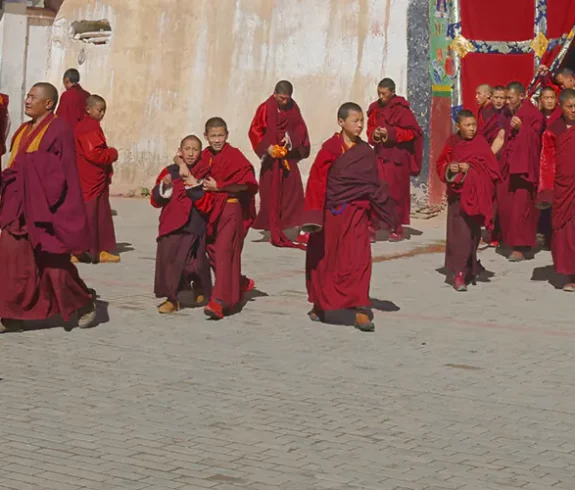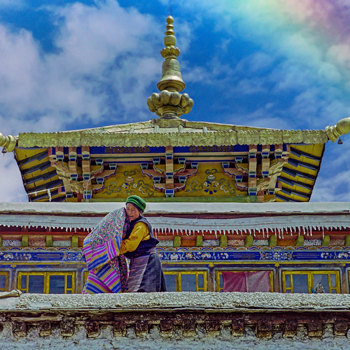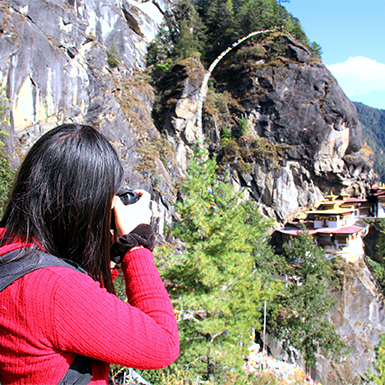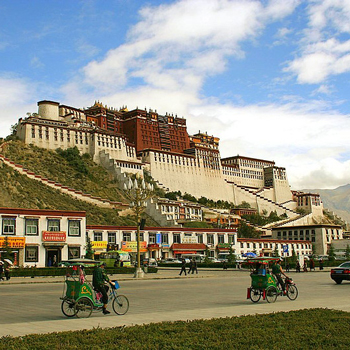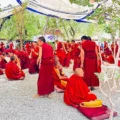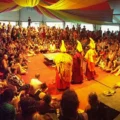Tibetan Buddhism, a vibrant tapestry woven with profound wisdom and colorful traditions, forms the very essence of Tibetan culture. This unique Mahayana Buddhist tradition, flourishing in the Himalayas for centuries, offers a practical path to enlightenment, guiding practitioners toward inner peace and liberation from suffering. This guide delves into the core practices, symbolism, schools, and experiences that define this fascinating spiritual realm.
- Tibetan Buddhism Practices: Explore meditation techniques for cultivating compassion, mindfulness, and insight. Discover practices like mantra recitation, visualization exercises, and prostrations designed to purify the mind and accumulate merit.
- Tibetan Buddhist Symbols: Uncover the rich symbolism embedded in thangkas (scroll paintings), mandalas (sacred diagrams), and prayer wheels. Discover how these symbols embody profound Buddhist concepts and are powerful tools for meditation and devotion.
- Buddhism Schools: Delve into the four primary schools of Tibetan Buddhism – Nyingma, Kagyu, Gelug, and Sakya – each characterized by its distinct philosophical approach and practices. Learn about the distinctive qualities of every lineage.
- Tibetan Monasteries Visit: Discover the etiquette and practicalities of visiting a Tibetan monastery. Learn about the architectural marvels and the daily routines of monks and nuns residing there.
- Tibetan Buddhist Festivals: Experience the vibrant world of Tibetan festivals, such as Losar (Tibetan New Year) and the Dalai Lama’s birthday. Witness colorful ceremonies, masked dances, and the joyous spirit of celebration.

Unveiling the Ancient Roots: A History
A Tibetan Buddhism guide is only complete with understanding its rich tapestry of history. It arose in the 7th Century CE, flourishing in the Himalayas’ unique cultural and geographical landscape. This unique tradition shares its foundation with Mahayana Buddhism, emphasizing compassion for all beings and pursuing enlightenment for their benefit.
Here, we explore some key milestones and influential figures that shaped Tibetan Buddhism:
Early Introduction (7th-8th Centuries CE): Buddhism arrived in Tibet through the efforts of dedicated figures like Shantarakshita (an Indian scholar-monk) and Padmasambhava (a revered tantric master). They established the first monasteries and translated Buddhist scriptures into Tibetan.
The Golden Age (8th-12th Centuries CE): This period witnessed a surge in the translation of Buddhist texts and the establishment of major monastic institutions. The influential Nyingma School, known for its emphasis on tantric practices, emerged during this time.
The Rise of New Schools (11th-13th Centuries CE): From the 11th Century onwards, new schools of thought arose, each with distinct interpretations of Buddhist teachings. Tsongkhapa founded the Gelug School, emphasizing monastic discipline and scholarship. Meanwhile, the Kagyu and Sakya schools, known for their unique lineages and tantric practices, also gained prominence.
Later Developments (14th Century Onwards): The Gelug School rose to political prominence, with the Dalai Lama becoming Tibet’s spiritual and temporal leader. Tibetan Buddhism continued to adapt and evolve, facing challenges and periods of cultural revival.
Unveiling the Path: Core Beliefs and Tibetan Buddhism Practices
Tibetan Buddhism Practices rest upon a foundation of core beliefs that illuminate the human condition. The concept of karma, the law of cause and effect, emphasizes the interconnectedness of actions and their consequences. Samsara, the cycle of rebirth, underscores the unsatisfying nature of our existence and the yearning for liberation. Finally, enlightenment, or Buddhahood, represents the ultimate goal – a state of perfect wisdom and compassion.
These beliefs translate into practical methods for achieving liberation. Meditation, a cornerstone of Tibetan practice, cultivates mental clarity and emotional stability. Chanting mantras, sacred syllables, or phrases is believed to purify the mind and connect practitioners with specific qualities or deities. Prostrations, full-body prostrations to the ground, express reverence and humility while offering physical benefits.
Exploring the Symbolic Landscape: Tibetan Buddhist Symbols
Tibetan Buddhism is a visually rich tradition that employs a vast array of symbols to convey profound meanings. The eight fortunate symbols, including the unending knot and lotus blossom, represent positive attributes like wealth and spiritual purity. Mandalas, with their complex religious designs, aid imagination and meditation. Depictions of Buddhas and Bodhisattvas, enlightened beings who vow to help others achieve enlightenment, inspire practitioners, and embody different aspects of spiritual development.
A Multifaceted Path: Tibetan Buddhism Schools
Buddhism encompasses four main schools, each offering a distinct approach to enlightenment. The Gelugpa tradition, known for its emphasis on monastic scholarship, produced the revered Dalai Lama lineage. The Nyingma School, the oldest tradition, emphasizes esoteric practices and teachings. The Kagyu and Sakya schools, known for their focus on meditation and direct transmission of knowledge from teacher to student, have produced numerous meditation lineages. Understanding these Schools allows you to find a path that resonates with your individual needs and inclinations.
A Sacred Encounter: Tibetan Monasteries Visit
Tibetan monasteries are vibrant cultural and spiritual centers. Visiting one offers a unique opportunity to experience firsthand. Witness monks engaged in daily rituals, marvel at intricate Buddhist art and soak in the serene atmosphere. Respectful dress and mindful behavior are essential when visiting monasteries. Some monasteries offer teachings or meditation sessions for visitors, allowing a deeper engagement with the tradition.
Celebrating the Dharma: Tibetan Buddhist Festivals
Tibetan Buddhist festivals enliven the year with vibrant celebrations. Losar, the Tibetan New Year, is a joyful event featuring colorful dances and offerings. The Kalachakra festival, a celebration of universal peace, features elaborate sand mandalas and empowerments, as well as special initiations bestowed by qualified teachers. Participating in these festivals provides a glimpse into the rich cultural tapestry of Tibetan Buddhism and the profound joy it cultivates.

Symbolism in Tibetan Buddhism
Visual imagery plays a profound role in Tibetan Buddhism, offering powerful tools for meditation, devotion, and understanding complex philosophical concepts. This section of the guide explores some of the most significant symbols encountered in Tibetan Buddhist practice.
Thangka Paintings: These vibrant, hand-painted scroll paintings depict Buddhas, bodhisattvas, deities, and spiritual scenes. Thangkas serve as visual representations of teachings, inspiring contemplation and devotion.
Mandala: These intricate circular diagrams represent the enlightened mind and the universe. Practitioners use mandalas for meditation, visualization practices, and offerings. The specific colors, shapes, and deities depicted within a mandala convey specific meanings and symbolism.
Prayer Wheels: Devotees spin cylindrical objects inscribed with mantras (sacred phrases). There are several beliefs associated with spinning a prayer wheel, including merit accumulation, negativity purification, and enlightenment seeds.
Dorje (Vajra): The Dorje, a thunderbolt, symbolizes the strength of knowledge and cunning tactics. The bell, often shown beside the Dorje, symbolizes the confluence of wisdom and compassion.
Endless Knot: An interwoven loop representing the cyclical nature of samsara and the endless knot of interdependent origination, where all phenomena arise from causes and conditions.
Major Schools of Tibetan Buddhism
Buddhism Schools weave the rich tapestry of Tibetan Buddhism, each offering unique interpretations of core teachings and practices. This section of our guide explores the four major schools: Gelug, Kagyu, Nyingma, and Sakya.
1. Gelug (The Yellow Hat School):
- Founded by Tsongkhapa in the 14th century, the Gelug School emphasizes monastic discipline, scholarship, and a structured approach to meditation.
- Gelug’s teachings are based on the works of Lama Tsongkhapa and prioritize logic and reason alongside devotion.
- The Dalai Lama is the most prominent figure in the Gelug School.
2. Kagyu (The Lineage of the Oral Transmission):
- Founded in the 11th century, the Kagyu School emphasizes the importance of a qualified teacher and the direct transmission of wisdom teachings from teacher to student.
- It is known for its focus on meditation practices, particularly those related to tantra (Vajrayana Buddhism).
- Sub-schools further divide the Kagyu School, each with its lineage and practices.
3. Nyingma (The Old Ones):
- Considered the oldest school of Tibetan Buddhism, the Nyingma tradition emphasizes the teachings and practices revealed in esoteric texts attributed to Padmasambhava.
- It offers a wider range of practices, including sutra and tantra, for practitioners of varying abilities.
- Nyingma monasteries often have a more relaxed atmosphere compared to other schools.
4. Sakya (The Grey Earth School):
- Founded in the 11th century, the Sakya School is known for its emphasis on logic, debate, and intellectual understanding of Buddhist philosophy.
- It places a strong emphasis on tantric practices and the importance of rituals for achieving enlightenment.
- The Sakya School is known for its scholarly tradition and influential commentaries on Buddhist scriptures.
Monastic Life in Tibetan Buddhism
Monasteries serve as the heart and soul of Tibetan Buddhism, acting as centers of learning, practice, and community. This section of our guide offers a glimpse into a Tibetan monastery’s daily life and structure.
A Day in the Life of a Tibetan Monk or Nun:
- Early Start: Monks and nuns typically rise before dawn for prayers, chanting, and meditation. These practices set the tone for a day dedicated to spiritual growth.
- Structured Schedule: The day unfolds with further prayer sessions, scripture study, philosophical debates, and household chores. This structured schedule fosters discipline and a sense of community.
- Monastic Studies: Depending on the school, monks and nuns may engage in advanced studies of Buddhist philosophy, tantric practices, and ritual performance. These in-depth studies deepen their understanding and equip them to guide others.
Monastic Hierarchy and Roles:
- Monks and Nuns Form the foundation of the monastic community, devoting their lives to study, practice, and upholding the monastic vows.
- Khenpo (Abbot): The respected head of the monastery is responsible for its spiritual and temporal well-being. The Khenpo provides guidance and ensures the smooth operation of the monastery.
- Lamas (Teachers): Offer invaluable guidance and instruction to monks and nuns, often specializing in specific teachings or rituals. Lamas play a vital role in transmitting knowledge and practices within the lineage.
- Geshes (Learned Masters): Hold the highest academic degree within Tibetan Buddhism, achieved through rigorous studies and examinations. Geshes are revered for their scholarship and contribute significantly to preserving and advancing Buddhist teachings.
Respectful Monastery Visits:
A Tibetan Buddhism guide would only be complete with proper etiquette for visiting monasteries. Here are some key points to remember:
- Dress modestly: Avoid loud or exposing attire and cover your knees and shoulders. Wearing appropriate clothing shows that you recognize the sacredness of the area.
- Be mindful of noise: Monasteries are places of prayer and meditation, so speak softly and avoid disruptive behavior. Maintaining a quiet atmosphere allows for contemplation and reverence.
- Photography etiquette: Ask permission before taking photos, and refrain from photographing monks or nuns during prayer sessions. Respect the privacy of those engaged in religious practices.
- Offerings: A small offering of money or incense shows respect for the monastery and its residents. Offerings contribute to the upkeep of the monastery and support the monastic community.
Unveiling the Celebrations: Festivals and Religious Ceremonies in Tibetan Buddhism
It pulsates with vibrant festivals and ceremonies throughout the year. These colorful celebrations offer a unique window into Tibetan culture, traditions, and the deep connection between the community and its spiritual beliefs. This section of our Tibetan Buddhism guide explores some major Tibetan Buddhist Festivals and their significance.
Unveiling the Tibetan Calendar:
Tibetan Buddhist Festivals follow a lunisolar calendar, with dates varying each year slightly. Here are some key festivals to experience the richness of Tibetan Buddhism:
- Losar (Tibetan New Year): This joyous festival, typically falling in February or March, marks the beginning of a new year. Losar festivities involve family gatherings, exchanging gifts, elaborate butter sculptures, and joyous public celebrations.
- Monlam Prayer Festival: Held in Lhasa during the first Tibetan month (usually February/March), the Monlam festival is a grand prayer gathering for world peace and the flourishing of Buddha-dharma (teachings). Monks from all Tibetan traditions participate in this elaborate ceremony filled with chanting, mandala offerings, and philosophical debates.
- Saga Dawa Duen: Commemorating the birth, enlightenment, and parinirvana (death) of Gautama Buddha, this festival falls on the full moon in the fourth Tibetan month (usually May/June). Observances include pilgrimage to sacred sites, offering butter lamps, and releasing animals as acts of merit.
- Shoton Festival: Celebrated during Tibetan yogurt month (usually July/August), the Shoton festival features a spectacular display of giant thangkas (scroll paintings) unfurled on monastery walls. Monks engage in lively debates, and traditional Tibetan opera performances fill the air with music and drama.
Significance of Festivals for Visitors:
These Tibetan Buddhist Festivals offer visitors a chance to:
- Witness Tibetan culture: Explore the rich tapestry of Tibetan culture, from traditional music and dance to colorful costumes and celebratory practices.
- Gain insights: Observe rituals, ceremonies, and artistic expressions that embody core Buddhist teachings and symbolism.
- Experience community spirit: Witness the strong sense of community and shared faith that permeates Tibetan society during these festivals.
Pilgrimage Sites in Tibetan Buddhism
Pilgrimage is a deep-rooted tradition in Tibetan Buddhism. Devout followers trip to sacred sites to accumulate merit, connect with the divine, and walk in the footsteps of enlightened beings. This section of our Tibetan Buddhism guide explores some of Tibet’s most important pilgrimage destinations.
A Land Steeped in Spirituality:
- Lhasa: The ancient capital of Tibet is home to the Jokhang Temple, considered to be the city’s spiritual hub, and Potala Palace, the former home of the Dalai Lama.
- Mount Kailash: This revered mountain, believed to be the center of the world in some Tibetan traditions, is a sacred pilgrimage site for Buddhists, Hindus, Bönpos, and Jains.

Starting a Tibetan Pilgrimage:
- Jokhang Temple: The statue of Jowo Shakyamuni, housed in the Jokhang Temple in the center of Lhasa, is thought to have been transported to Tibet by Princess Wencheng in the seventh century. As a religious ritual, pilgrims walk around the temple.
- Mount Kailash Circuit: The Mount Kailash Kora, a 3-day trek around the mountain, is a challenging yet deeply rewarding pilgrimage. Prepare for Tibet’s high altitude and harsh weather conditions.
Respectful Engagement with Sacred Sites:
- Dress modestly: Opt for conservative clothing that covers shoulders and knees. It shows respect for the sacred nature of the pilgrimage sites.
- Offerings: Pilgrims traditionally offer butter lamps, incense, or small katas (Tibetan scarves) to show reverence and accumulate merit.
- Mindful behavior: Maintain a peaceful and respectful demeanor. Avoid loud noises and disruptive behavior to preserve the tranquility of these sacred spaces.
Planning Your Pilgrimage:
- Permits and logistics: Certain pilgrimage sites, particularly Mount Kailash, require special permits. Plan your trip well in advance and arrange logistics with a reputable tour operator.
- Physical fitness: Some pilgrimage routes, like Mount Kailash Kora, require extensive physical fitness and acclimatization to altitudes.
- Respect local culture. Tibetan culture has numerous traditions. Throughout your pilgrimage, keep in mind the manners and traditions of the place you are visiting.
Unveiling Respect: Tips for Visiting Tibetan Buddhist Sites
Tibetan Buddhism thrives on a foundation of respect and reverence. It extends to how visitors approach monasteries and pilgrimage sites and interact with monks and the lay community. This section of our guide equips you with a respectful and enriching visit.
Monastery and Temple Etiquette:
- Dress Modestly: Opt for clothing that covers shoulders and knees. Avoid loud colors or revealing attire.
- Mindful Movement: Pad and avoid disrupting ongoing prayers or ceremonies.
- Photography Courtesy: Ask permission before taking photos, and refrain from photographing monks or nuns during prayer sessions.
- Offerings: A small offering of money or incense shows respect for the monastery and supports its upkeep.
Engaging with the Monastic Community:
- Greetings: A respectful bow with a slight smile is a customary greeting. Due to their vows, monks and nuns may refrain from engaging in extended conversations.
- Monetary Offerings: Offer money directly or place it in designated donation boxes. Avoid directly putting money in the hands of monks or nuns.
Interacting with the Lay Community:
- Greetings: A friendly smile and a slight bow are appropriate greetings.
- Respectful Inquiry: If interested in local customs or traditions, ask questions politely and respectfully.
- Sensitivity: Be mindful of religious practices and avoid discussions on sensitive political topics.
General Tips:
- Remove shoes: Customarily, you should remove your shoes before entering temples or monasteries. Look for designated shoe racks or areas.
- Circumambulation: Always proceed clockwise when circumambulating (walking around) sacred sites.
- Public Displays of Affection: Public displays of affection are not customary in Tibetan culture.
A Conclusion to Your Tibetan Buddhism Guide
This guide aims to unveil the rich tapestry of this spiritual tradition. We’ve explored core practices like meditation and mantra recitation, delved into the symbolism that adorns Tibetan Buddhist Symbols, and introduced the diverse schools that shape this path. We hope it has sparked your curiosity and provided a foundation for further exploration.
A Journey of Open-Mindedness:
Tibetan Buddhism provides a unique perspective on the world, focusing on compassion, wisdom, and the potential for enlightenment. As you explore this tradition, keep in mind:
- Respectful Inquiry: Come with a genuine interest in learning and a willingness to understand a different worldview.
- Open-Mindedness: Be open to new ideas and practices that may differ from your cultural background.
- Responsible Exploration: If visiting Tibetan cultural sites, respect and be mindful of local customs and traditions.
The Path Forward:
This guide serves as a starting point. There’s a wealth of resources available to deepen your understanding:
Books: Explore books on Tibetan Buddhist teachings by renowned teachers like the Dalai Lama or Thich Nhat Hanh.
Documentaries: Watch documentaries that showcase Tibetan Buddhist practices and culture.
Meditation Centers: Consider attending meditation classes or workshops led by qualified Buddhist teachers.
